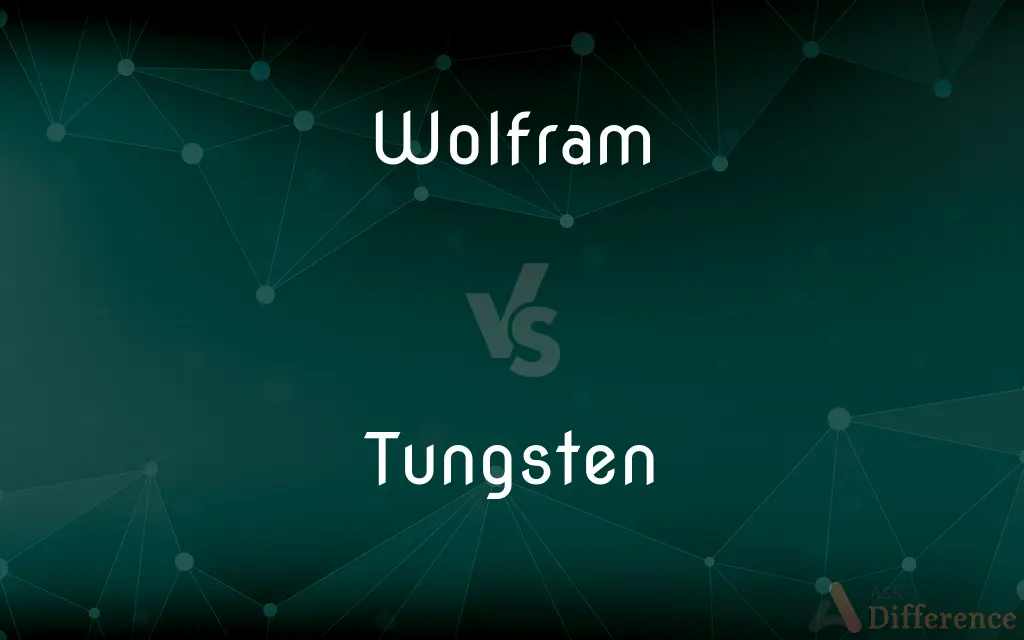Wolfram vs. Tungsten — What's the Difference?
By Tayyaba Rehman & Urooj Arif — Updated on March 25, 2024
Wolfram and Tungsten refer to the same chemical element (W) but are used differently based on linguistic and regional preferences.

Difference Between Wolfram and Tungsten
Table of Contents
ADVERTISEMENT
Key Differences
Wolfram, also known by the symbol 'W', is the term predominantly used in many European languages to describe the chemical element with atomic number 74. It was named after the mineral wolframite, from which it was first isolated. On the other hand, Tungsten is the name widely adopted in English-speaking countries, derived from the Swedish words "tung sten," meaning "heavy stone," indicative of its high density.
The history of wolfram dates back to the 18th century when it was discovered within wolframite. This terminology is still prevalent in scientific literature and discussions within certain linguistic groups. Whereas, the term tungsten was established almost concurrently, emphasizing the element's significant weight and its distinct properties, such as the highest melting point of all metals.
In terms of applications, both wolfram and tungsten play critical roles in various industries, from manufacturing filaments in light bulbs to being alloyed with steel to enhance its strength and high-temperature resistance. The difference in terminology does not affect the element's application but may influence regional labeling and marketing strategies.
Scientifically, there is no distinction between wolfram and tungsten; they are simply two names for element 74 on the periodic table. However, the usage of "wolfram" versus "tungsten" can reflect historical, cultural, and linguistic influences, particularly in academic and industrial contexts.
The IUPAC (International Union of Pure and Applied Chemistry) recognizes "tungsten" as the official name for the element to standardize scientific communication. Despite this, the symbol 'W' is derived from "wolfram," acknowledging the element's history and its diverse nomenclature across different languages and regions.
ADVERTISEMENT
Comparison Chart
Name Origin
From "wolframite," the mineral it was first isolated from
From Swedish "tung sten," meaning "heavy stone"
Linguistic Use
Preferred in many European languages
Widely used in English-speaking countries
Historical Discovery
18th century, within wolframite
18th century, known for its high density
Applications
Identical to tungsten
Identical to wolfram
Scientific Distinction
None, both refer to the chemical element with symbol 'W'
None, both refer to the chemical element with symbol 'W'
Compare with Definitions
Wolfram
Known for its high melting point.
Wolfram's durability makes it ideal for high-temperature applications.
Tungsten
A heavy metal known for its robustness.
Tungsten is favored for its strength and high melting point.
Wolfram
Utilized in the production of filaments.
Many older light bulbs use wolfram filaments.
Tungsten
Essential in the production of hard materials.
Tungsten carbide is renowned for its hardness and wear resistance.
Wolfram
Historical term in European scientific literature.
European researchers often refer to element 74 as wolfram.
Tungsten
The official IUPAC name for element 74.
In scientific discussions, tungsten is the recognized term for 'W'.
Wolfram
A chemical element with symbol 'W' and atomic number 74.
Wolfram is extensively used in making alloys.
Tungsten
Used in lighting technology.
Tungsten filaments revolutionized the lighting industry.
Wolfram
Integral in manufacturing tungsten carbide.
Wolfram carbide is a critical component in cutting tools.
Tungsten
Common in metalworking applications.
Tungsten alloys are crucial for aerospace and military hardware.
Wolfram
See tungsten.
Tungsten
Tungsten, or wolfram, is a chemical element with the symbol W and atomic number 74. Tungsten is a rare metal found naturally on Earth almost exclusively as compounds with other elements.
Wolfram
Wolframite
Tungsten
A hard, brittle, corrosion-resistant, gray to white metallic element extracted from wolframite, scheelite, and other minerals, having the highest melting point and lowest vapor pressure of any metal. Tungsten and its alloys are used in high-temperature structural materials and wear-resistant tools and machine parts; in electrical elements, notably lamp filaments; and in instruments requiring thermally compatible glass-to-metal seals. Atomic number 74; atomic weight 183.84; melting point 3,422°C; boiling point 5,555°C; specific gravity 19.3 (20°C); valence 2, 3, 4, 5, 6. Also called wolfram. See Periodic Table.
Wolfram
(dated) tungsten
Tungsten
A rare metallic chemical element (symbol W, from Latin wolframium) with an atomic number of 74.
Wolfram
Same as Wolframite.
Tungsten
A light bulb containing tungsten.
Wolfram
Same as tungsten.
Tungsten
Scheelite, calcium tungstate
Wolfram
A heavy gray-white metallic element; the pure form is used mainly in electrical applications; it is found in several ores including wolframite and scheelite
Tungsten
A rare element of the chromium group found in certain minerals, as wolfram and scheelite, and isolated as a heavy steel-gray metal which is very hard and infusible. It has both acid and basic properties. When alloyed in small quantities with steel, it greatly increases its hardness. Symbol W (Wolframium). Atomic weight, 183.6. Specific gravity, 18.
Tungsten
Scheelite, or calcium tungstate.
Tungsten
A heavy gray-white metallic element; the pure form is used mainly in electrical applications; it is found in several ores including wolframite and scheelite
Common Curiosities
What does the symbol 'W' stand for?
The symbol 'W' stands for wolfram/tungsten, reflecting its original name from wolframite.
Why do English-speaking countries prefer the term tungsten?
The term "tungsten" comes from Swedish, and English-speaking countries adopted it due to its meaning "heavy stone," reflecting the metal's density.
Why is tungsten important in industry?
Tungsten's high melting point and strength make it essential for manufacturing and technology applications.
What are the key properties of tungsten?
Tungsten has the highest melting point of all metals, high density, and exceptional strength at high temperatures.
Can wolfram and tungsten be used interchangeably?
Yes, in the context of the chemical element, they are interchangeable, though regional preferences may vary.
Where is wolfram found?
Wolfram is found in minerals such as wolframite and scheelite, from which it is extracted.
Is there a difference between wolfram and tungsten?
No, they are two names for the same chemical element, differing only in linguistic and regional use.
What is wolfram used for?
Wolfram is used in alloys, lighting, electronics, and as tungsten carbide for cutting tools.
How is tungsten produced?
Tungsten is produced by reducing tungsten oxide from its ores with hydrogen or carbon.
What is the significance of tungsten in the periodic table?
Tungsten's significance lies in its unique chemical and physical properties, making it invaluable across many scientific and industrial fields.
How do cultural and linguistic differences influence the name used for this element?
Cultural and linguistic preferences influence the choice between "wolfram" and "tungsten," reflecting historical and regional variations in language.
What role does tungsten play in modern technology?
It's crucial for electronic devices, lighting, aerospace, and military applications due to its unique properties.
Why does IUPAC recognize "tungsten" as the official name?
IUPAC aims for standardization in chemical nomenclature, and "tungsten" is the widely accepted term in scientific literature.
Is tungsten environmentally friendly?
Tungsten is considered environmentally friendly due to its low toxicity and recyclability.
How does the term wolfram reflect the element's characteristics?
"Wolfram" reflects the element's discovery within wolframite, highlighting its historical extraction process.
Share Your Discovery

Previous Comparison
Earn vs. Get
Next Comparison
Bluetooth vs. WirelessAuthor Spotlight
Written by
Tayyaba RehmanTayyaba Rehman is a distinguished writer, currently serving as a primary contributor to askdifference.com. As a researcher in semantics and etymology, Tayyaba's passion for the complexity of languages and their distinctions has found a perfect home on the platform. Tayyaba delves into the intricacies of language, distinguishing between commonly confused words and phrases, thereby providing clarity for readers worldwide.
Co-written by
Urooj ArifUrooj is a skilled content writer at Ask Difference, known for her exceptional ability to simplify complex topics into engaging and informative content. With a passion for research and a flair for clear, concise writing, she consistently delivers articles that resonate with our diverse audience.















































